El ácido úrico elevado en sangre, conocido como hiperuricemia, puede originar la formación de cristales de urato en las articulaciones. Esto provoca inflamación y dolor, especialmente en articulaciones pequeñas como los nudillos de los dedos de las manos o los pies.
Además de las articulaciones periféricas, algunas personas presentan molestias en la espalda baja. En ciertos casos, la inflamación asociada a ácido úrico puede afectar la columna o coexistir con otras enfermedades inflamatorias como la espondiloartritis.
La relación entre inflamación articular y dolor lumbar se entiende como parte de un proceso sistémico. La gota y otras artritis inflamatorias se vinculan al síndrome metabólico, la obesidad y dietas ricas en purinas, lo que contribuye a elevar el ácido úrico en sangre.
El ayuno de 36 horas, practicado de manera controlada, ha mostrado en estudios preliminares una reducción de marcadores inflamatorios y una mejor regulación metabólica. Sin embargo, a corto plazo puede aumentar transitoriamente los niveles de ácido úrico debido a la competencia con los cuerpos cetónicos en la excreción renal.
Por ello, aunque el ayuno prolongado puede ofrecer beneficios en la reducción de inflamación y en la salud metabólica, su práctica debe realizarse con precaución y, de ser posible, bajo supervisión médica en personas con antecedentes de gota o hiperuricemia.
Fuentes citadas:
1) Mayo Clinic. *Gout: Symptoms and causes*. https://www.mayoclinic.org/diseases-conditions/gout/symptoms-causes/syc-20372897
2) National Institute of Diabetes and Digestive and Kidney Diseases (NIDDK). *Hyperuricemia and Gout*. https://www.niddk.nih.gov/health-information/kidney-disease/hyperuricemia-gout
3) Longo VD, Mattson MP. *Fasting: Molecular Mechanisms and Clinical Applications*. Cell Metab. 2014. https://doi.org/10.1016/j.cmet.2013.12.008
